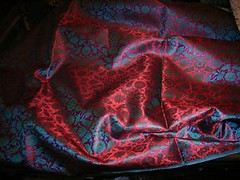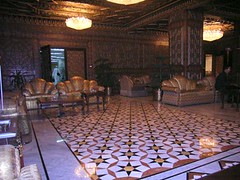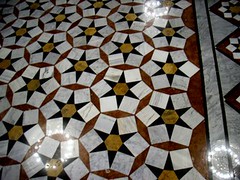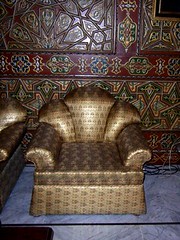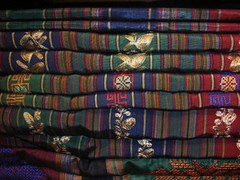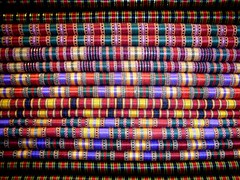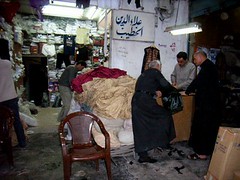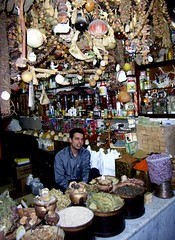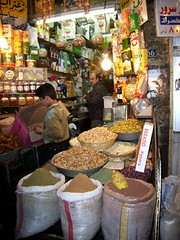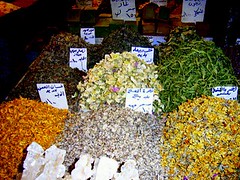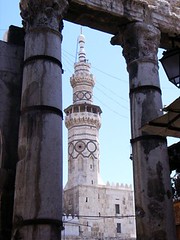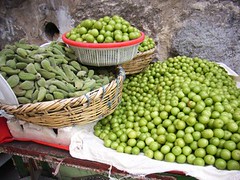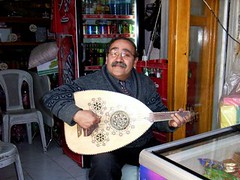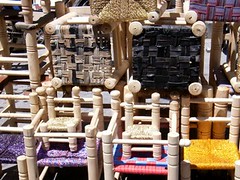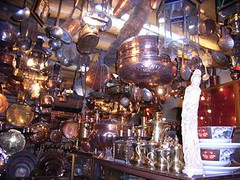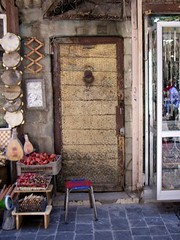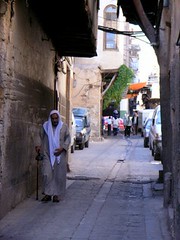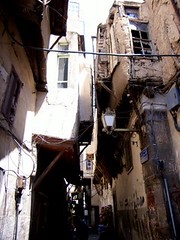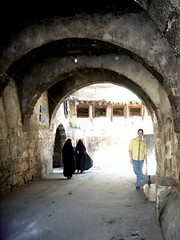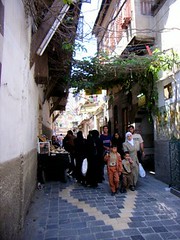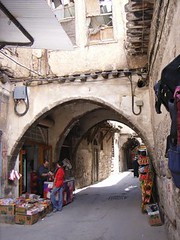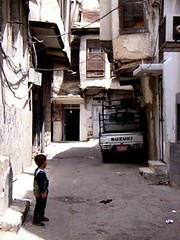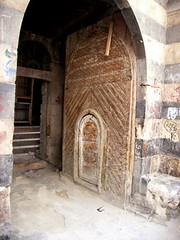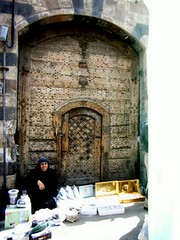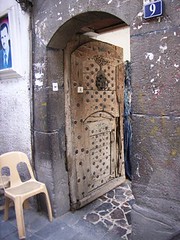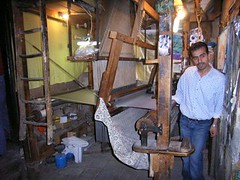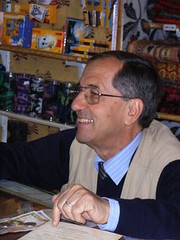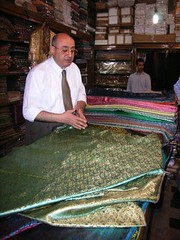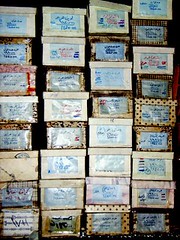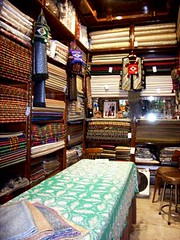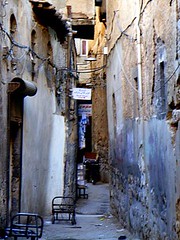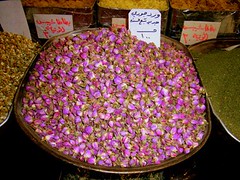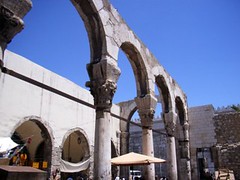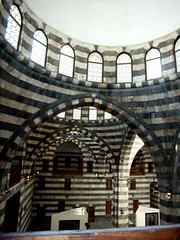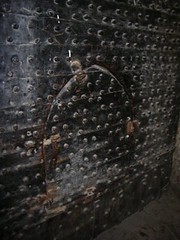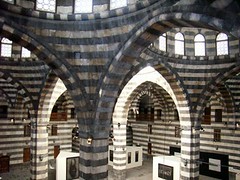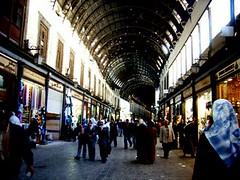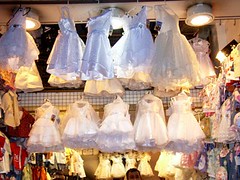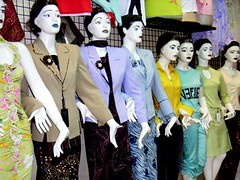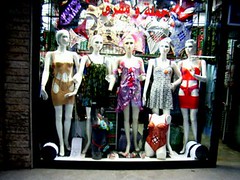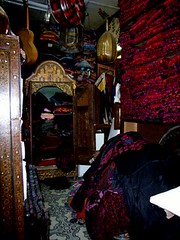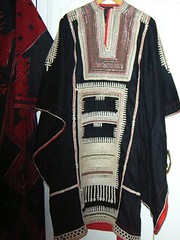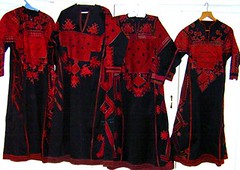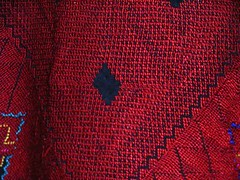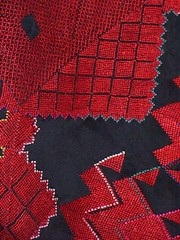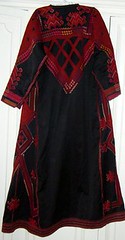Between the Street Called Straight (which has a kink in the middle) and the end of the Suq Hamidyeh at the Omayed Mosque is the sweet suq. In the beginning of this suq, just across from the Azem Palace, is a small shop, enclosed, unlike those around where the wares are spread out to be viewed. Here there is a longish entrance with glass fronted cabinets displaying the beautiful inlaid wooden boxes for which Damascus is famous. On the front door is a sign “Purveyors to HM Queen Elizabeth 11. They once had the official sign with the coat of arms, but the door was broken and they had to have an etched sign made instead.
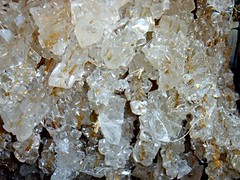
Sugar Crystals from the sweet suq
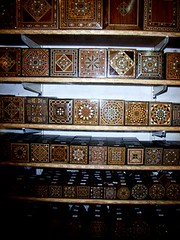
Wooden boxes, to be filled with sweets
This is Ghraouis. It is the best known sweet shop in Syria, and possibly one of the best in the Middle East, where sweet making comes second only to religion in importance. This is an extraordinary sweet shop. These are the sweets of One Thousand Nights and a Night. I have loved this way of translating it, as it is so much closer to the sense of poetry of this part of the world than our rather ordinary Thousand and One Nights.
There are no new flavours, for these combinations have been blended with care for the last two hundred years by the same family. Unlike most things in Syria, these sweets are not cheap, and a kilo will cost about $25 Australian. Just as well, as otherwise I would buy half the shop.
My favourite is a long ridged log with an outside coating of marzipan – and this is not the heavily enriched with almond flavouring that we often get in Australia – but a delicately rich crisp coating. This is scored deeply twice on one edge, and in the scores there is a greenish glow. This side is toasted to give a toasted almond ridge on one side only. Inside the almond coating is a puree of moist, slightly sweetened, pistachio, granular but with an occasional whole nut. This is nuts on nuts, a mealy sandy texture on the tongue, the slight bitterness of fresh almonds, and the sweetness and colour and unique scent of pistachios.
For those who prefer their marzipan less adulterated, there are wonderful marzipan roses, perfectly modeled and formed and about three inches across, marzipan slightly scented with rose water. These are pure Middle East, and almost confusing for the rose scent is just that, a scent in your nose, but so delicate on the tongue that it hardly exists.
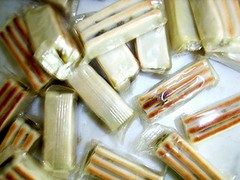
Marzipan stuffed with pistachio paste
Now reach for one of the firm gold wrapped logs. These are a firm paste of tangy apricot holding together whole pistachios. These are dredged in icing sugar before they are wrapped, so opening the paper releases a cloud of fine sugar into the air that reaches your tongue before the sweet, waking up taste buds for the explosive tang of apricot. This dusting is the only added sugar, but it ensures that you breathe out as you bite, not in, or you inhale the powder. It is not a great idea to eat these in a black shirt! They are the perfect thing in a handbag for traveling or for those times where you want something – but want to feel that it is reasonably healthy.
Try the logs of nougat – packed separately in see-through wraps to tempt you. There are pistachios which are so much greener than the ones we usually see, bonded in a honeyed nougat, there are nougats of toasted almonds with the scent of rosewater. There is louqum – which we often call Turkish delight. Syrians claim it though, as does Iran and other areas around here. We tend to think of it as only pink and rose water flavoured, and with that soft but stretchy texture. Here is has many variations, though it is usually firmer and less gelatinous, and it is used a bonding for confections of nuts and fruits. You can buy soft discs of pistachios, flavoured with orange flower water where the outsides are covered in fine orange rind, and logs of toasted almonds with a coating of sesame seeds, or walnuts all held together with louqum.
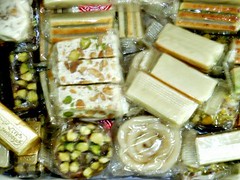
Ghraoui has caramels, softer than Columbines, and more richly flavoured, and jellies of many colours and flavours, so soft they shimmy in their piles if you bump the table which displays them. These, or ones like them, are sold all around the sweet suq, and often on mobile carts and in all sorts of brilliant colours, for many other companies use strong colouring for its child appeal. The huge piles of spiral-stacked jellies undulate gently as they approach over the cobblestones.
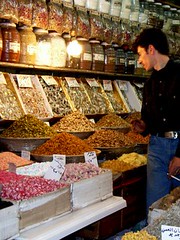
Sweets and spices in a shop the open suq.
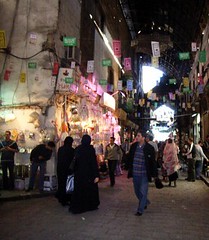
Looking into the sweet suq with Ghraoui's on the right but not visible.
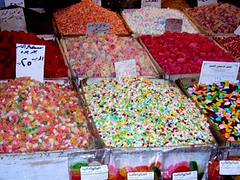
The tiny sugared sweets in the very front are anise seeds and fennel coated in coloured sugar. All these cheap sweets sell at about 50 cents a kilo.
They make the sweets for which Ghraoui, and Damascus are most famous, whole fruits, often with the seeds still inside, cooked whole in sugar syrups and set, slightly gelatinous, in paper cups which hold them. These must be the sugar plums, of the sugar plum fairy! They are rich and a bit sweet to my taste. More jammy in flavour than our crystallized fruits with the essence of the fruit, dates, apricots, plums, figs, whole small peaches, tiny apples no more than two inches in diameter, tiny pears before corellas were trendy in Australia, rolls of orange rind with none of the nasty bitterness of our candied peel, but holding the essence of that sunshine filled flavour of the whole fruit. Sometimes they pack apricot halves, seeds removed, and stud them with whole pistachios like birds nests complete with eggs, and stuff several ‘nests’ into a paper case.
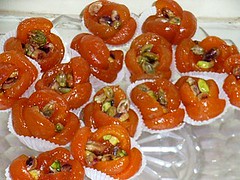
However, the best of all are the chocolates. They coat everything in rich dark bitter chocolate, no mild or gentle flavours here. They fill them with rough crushed coffee beans, with pastes of orange rind and crushed almond, with pistachio paste with a whole pistachios studded through it, they coat all the louqum varieties, and the apricot and pistachio pastes. The croquant is a dark toffee thick with toasted almonds, but in thin and delicate slices and coated with chocolate so it is crisp on the teeth, but not hard to eat. These are the other side of the coin from Swiss chocolate, with its buttery richness and delicacy of flavours. These are the worker class of chocolate, rough and guttural and wholehearted, each with a blast of flavour. They cannot be eaten absentmindedly in front of television. They demand full attention.
No wonder Queen Elizabeth still orders them occasionally.
 Wednesday, May 11, 2005 at 09:50AM
Wednesday, May 11, 2005 at 09:50AM 